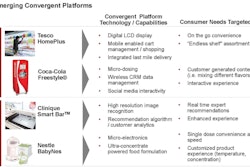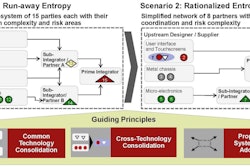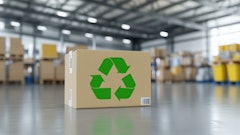Imagine the scenario. You’re done with your holiday shopping, Christmas day comes around and gifts are passed out—some of which are kept and some of which are returned to retail stores. Opened but intact items get put back on the store shelf for resale with an “opened item” sticker slapped on the box. While other items—think electronics like a cell phone or laptop computer—get returned to the manufacturing warehouse, refurbished and resold at a lower cost. Sounds simple, right?
But now imagine that for that one toaster oven you returned, consumers all over the country can be returning that exact same toaster oven made by the same manufacturer. Aside from all the logistics that went into getting that item to a retail store close to you, now those production, distribution and transportation processes are multiplied by the hundreds of returns of that one item. Thus, the reverse logistics process is now more of a challenge than perhaps the initial flow of goods in the forward supply chain.
While automation and standardized processes can help, the crux of the matter is not all reverse logistics processes are the same and a one-size-fits-all approach does not always work. Companies need to ensure they have the expertise on hand to manage reverse logistics—as equally an important function as the forward-moving processes in supply chain.
“It used to be sort of an afterthought to take care of reverse logistics—this part of the supply chain has been ignored by many entities just because you can put excess items on a truck and go put them in a hole in the ground somewhere or push them off to the end of the pier,” said Tom Burton, President of Government Liquidation LLC (of Liquidity Services Inc., which provides full service solutions to sell surplus assets). “But now, this is becoming a job for the experts. The other piece of it is the compliance part. Some of that excess property, you just can’t put in a pile and say ‘take this away’ because there could be hazardous characteristics that could make that property risky—so it needs to be controlled.”
Within the government
For DLA Disposition Services, which handles disposition of property, reverse logistics is always a continuing education process—especially at the federal level. “The pace of current operations has had people focused so much on military deployment, completing their mission and coming back,” explained Ken MacNevin, Chief of Public Affairs for the Defense Logistics Agency (DLA). As a result, “there’s a turnover of people every two to four years at the government level,” MacNevin confirmed.
To address this, DLA Disposition Services rolls out classes at school houses where military are deployed to address such reverse logistics of items out in the field. For example, some of those personnel based in Afghanistan have the responsibility of sorting, separating and deciding which items come back to the United States, explained MacNevin.
“And there could be 1,001 factors that influence how that work goes on,” he said. “So it starts with the units in the big sort yards. Units that deploy have a lot more scrap materials. There are also items that may be obsolete for one unit but still of interest to another federal agency. Then there is downsizing which generates a lot of excess material. So there is more generated today in terms of useable property. Federal agencies look to us more for things they may have bought in lean budget times on their own,” but that now can be repurposed elsewhere, MacNevin continued.
Some of the other items that are turned in to DLA Disposition Services include old gun barrels from army tanks and other types of property—such as electronics that have specific metals— that require a different treatment. In the case of USS Long Beach—commissioned in 1961 as the first nuclear-powered guided-missile cruiser—the historic navy cruiser was turned over to DLA Disposition Services who then worked with Government Liquidation, tasked with marketing the cruiser and selling it to an appropriate buyer.
Military practices
With such large items and material unlike the useable property that comes into DLA Disposition Services, the agency turns to Government Liquidation, which sells over two billion pounds of scrap material and over 5.6 million surplus items—adding to its green initiative, a factor which serves as another important function of reverse logistics that experienced added attention from companies in the supply chain.
Such was the scenario in the case of the USS Long Beach. Deactivated in 1994, the superstructure of the vessel was removed, reactors were defueled and the cruiser was towed through the Panama Canal to Puget Sound Naval Shipyard in Bremerton, Washington where it was held until further recycling measures were taken. Most recently—and in support of one of the largest green and zero-waste initiatives in U.S. government history—the vessel was auctioned off July 10th through July 12th for its scrap metal components through Government Liquidation.
“As the USS Long Beach was dismantled, we had to identify bidders that were capable of removing the metal as it was coming away from the ship,” explained Burton. “The government is committed to zero waste. Even the slag that is generated from cutting torches is collected and put in hoppers to be removed. So it’s not haphazard—the process is planned well in advance. We set up an auction and we qualified bidders to make sure they had the capability to meet the requirements of Puget Sound—which is more critical than most because their space is just so limited. There is property that is turned in as excess nearly every week. And the following week, there is more property. And this is the same problem at all 200 or so military bases,” he continued.
A global seller of assets in over 500 different U.S. government commodity categories—such as aircraft parts and industrial machinery and equipment—Government Liquidation operates an online sales portal to allow surplus and scrap buyers to purchase available government assets. The company promotes property for sale with approximately 1,000 videos per week and over one million photos per year to over two million registrants to make this property available to as large an audience as possible to find the best use for it.
And as a contractor of the DLA Disposition Services for the sale of surplus and scrap assets of the United States Department of Defense (DOD), Government Liquidation knows first-hand the number of more finite details—with strict compliance to safety, environmental and security restrictions as a large component of that—that are involved with reverse logistics in this realm than perhaps in a different industry segment.
“The one thing that all this property has in common is that it was purchased by the Department of Defense for the U.S. military,” said Burton. “So while some of this property may have originally had a military purpose, the government wants to know who is buying it and what will that material be used for. Because it is the government, we need to make sure that we keep good records of the material, we don’t let property sit idle, we make sure that space is available to hold next week’s collections—such as for some of the high-interest items.”
Not surprisingly, some of the processes involved require correct documentation which the government requires for some of the “end-use certificate” purchases. For example, Government Liquidation receives FDA certificates for medical devices or any type of potentially-hazardous material, which verifies if an item has been properly handled and is disposed of toxic components. In addition, Government Liquidation has a safety program and a risk management department to comply with DLA Disposition Services’ rules and regulations.
Throughout the bid process, Government Liquidation identified Tacoma Metals with the winning bid which met all the requirements for the scrap removal process of the cruiser. To date, of the 7.35 million pounds of scrap assets of which the USS Long Beach was sold for back in the June/July timeframe, over 140,000 pounds of material was removed thus far, according to Burton (the project is ongoing under a three-year term).
Down the reverse logistics line
In addition to some of the space challenges that add to the need for more sustainable reverse logistics, other trends on the horizon include the outsourcing of such processes.
Reverse logistics is not an afterthought as much anymore even if people keep it in house,” said Burton. “But the trend will be to outsource it. And Liquidity Services is committed to this long term as this is going to be a job for professionals in the future that is going to include states, municipalities and other government entities. Because the requirements are becoming stricter and you can’t just throw things in the ground and cover them up anymore, the trend will be to outsource.”
“Our primary focus is and will always be taking out the stewardship of military units and providing them with the equipment they need—adding to the quality of life,” MacNevin also added. “By electing a contract, we moved the cost of doing the sale of material to the public to a contractor. We also moved the cost of the infrastructure required to hold the material if we were going to sell it.”
Looking ahead, regardless of industry segment, reverse logistics processes will become a more integral component of the supply chain as companies look to sustainable and ROI-generating methods to dispose of and reuse goods and materials. Suffice to say that even at the government level, such large masses of property—that may be excess to military activities—don’t necessarily meet their end and can instead, serve a purpose elsewhere.


![Pros To Know 2026 [color]](https://img.sdcexec.com/mindful/acbm/workspaces/default/uploads/2025/08/prostoknow-2026-color.mduFvhpgMk.png?auto=format%2Ccompress&bg=fff&fill-color=fff&fit=fill&h=100&q=70&w=100)







![Pros To Know 2026 [color]](https://img.sdcexec.com/mindful/acbm/workspaces/default/uploads/2025/08/prostoknow-2026-color.mduFvhpgMk.png?ar=16%3A9&auto=format%2Ccompress&bg=fff&fill-color=fff&fit=fill&h=135&q=70&w=240)








